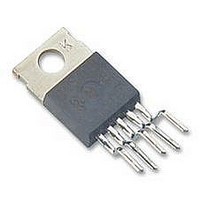LM2575T-12 National Semiconductor, LM2575T-12 Datasheet - Page 20

LM2575T-12
Manufacturer Part Number
LM2575T-12
Description
Voltage Regulator IC
Manufacturer
National Semiconductor
Specifications of LM2575T-12
No. Of Pins
5
Output Current
1A
Peak Reflow Compatible (260 C)
No
Output Voltage
12V
Termination Type
Through Hole
Supply Voltage Max
40V
Leaded Process Compatible
No
Mounting Type
Through Hole
Lead Free Status / RoHS Status
Contains lead / RoHS non-compliant
Available stocks
Company
Part Number
Manufacturer
Quantity
Price
Part Number:
LM2575T-12
Manufacturer:
NS/国半
Quantity:
20 000
Company:
Part Number:
LM2575T-12G
Manufacturer:
ON Semiconductor
Quantity:
378
www.national.com
Application Hints
Since the lead frame is solid copper, heat from the die is
readily conducted through the leads to the printed circuit
board copper, which is acting as a heat sink.
For best thermal performance, the ground pins and all the
unconnected pins should be soldered to generous amounts
of printed circuit board copper, such as a ground plane.
Large areas of copper provide the best transfer of heat to the
surrounding air. Copper on both sides of the board is also
helpful in getting the heat away from the package, even if
there is no direct copper contact between the two sides.
Thermal resistance numbers as low as 40˚C/W for the SO
package, and 30˚C/W for the N package can be realized with
a carefully engineered pc board.
Included on the Switchers Made Simple design software is
a more precise (non-linear) thermal model that can be used
to determine junction temperature with different input-output
parameters or different component values. It can also calcu-
late the heat sink thermal resistance required to maintain the
regulators junction temperature below the maximum operat-
ing temperature.
Additional Applications
INVERTING REGULATOR
Figure 10 shows a LM2575-12 in a buck-boost configuration
to generate a negative 12V output from a positive input
voltage. This circuit bootstraps the regulator’s ground pin to
the negative output voltage, then by grounding the feedback
pin, the regulator senses the inverted output voltage and
regulates it to −12V.
For an input voltage of 12V or more, the maximum available
output current in this configuration is approximately 0.35A. At
lighter loads, the minimum input voltage required drops to
approximately 4.7V.
The switch currents in this buck-boost configuration are
higher than in the standard buck-mode design, thus lowering
NEGATIVE BOOST REGULATOR
Another variation on the buck-boost topology is the negative
boost configuration. The circuit in Figure 11 accepts an input
voltage ranging from −5V to −12V and provides a regulated
−12V output. Input voltages greater than −12V will cause the
output to rise above −12V, but will not damage the regulator.
(Continued)
FIGURE 10. Inverting Buck-Boost Develops −12V
20
the available output current. Also, the start-up input current
of the buck-boost converter is higher than the standard
buck-mode regulator, and this may overload an input power
source with a current limit less than 1.5A. Using a delayed
turn-on or an undervoltage lockout circuit (described in the
next section) would allow the input voltage to rise to a high
enough level before the switcher would be allowed to turn
on.
Because of the structural differences between the buck and
the buck-boost regulator topologies, the buck regulator de-
sign procedure section can not be used to select the inductor
or the output capacitor. The recommended range of inductor
values for the buck-boost design is between 68 µH and 220
µH, and the output capacitor values must be larger than what
is normally required for buck designs. Low input voltages or
high output currents require a large value output capacitor
(in the thousands of micro Farads).
The peak inductor current, which is the same as the peak
switch current, can be calculated from the following formula:
Where f
current operating conditions, the minimum V
the worst case. Select an inductor that is rated for the peak
current anticipated.
Also, the maximum voltage appearing across the regulator is
the absolute sum of the input and output voltage. For a −12V
output, the maximum input voltage for the LM2575 is +28V,
or +48V for the LM2575HV.
The Switchers Made Simple (version 3.3) design software
can be used to determine the feasibility of regulator designs
using different topologies, different input-output parameters,
different components, etc.
Because of the boosting function of this type of regulator, the
switch current is relatively high, especially at low input volt-
ages. Output load current limitations are a result of the
maximum current rating of the switch. Also, boost regulators
can not provide current limiting load protection in the event of
a shorted load, so some other means (such as a fuse) may
be necessary.
osc
= 52 kHz. Under normal continuous inductor
01147515
IN
represents














